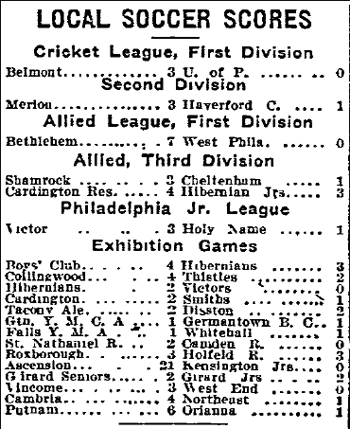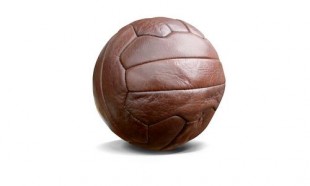In the beginning days of league soccer in Philadelphia, games were almost exclusively played on Saturday afternoons. Primarily, this was due to the simple fact that players were not professionals and so had to work for a living. For many players this would mean working in industrial jobs in Philadelphia’s many factories and mills. Understandably, many players would have been too tired to play regularly scheduled competitive soccer matches after a long workday. With league play taking place in the fall and winter months—when days are short and nightfall begins early—the absence of lighted fields would have ruled out Monday through Friday matches.
The one day of the week which most workers could be certain of having off was Sunday. However, Pennsylvania’s blue law of 1794 (a law which would remain in effect until 1934) prohibited “all sports and diversions” on Sundays. So, with work on Saturdays for most players being likely to end around noon (the 40 hour work week was an evolving proposition that wasn’t realized by most workers until the Fair Labor Standards Act of 1937), Saturday afternoon was the only time of the week available for matches. The general exception to Saturday games were holidays matches, particularly on Thanksgiving and Christmas.
A long tradition
The tradition of exhibition soccer games on Thanksgiving and Christmas in Philadelphia stretched back at least to 1889 when the first organized league in the city, the five-teams Pennsylvania Football Union, organized two Thanksgiving games. The first took place in the morning at Wayne Junction and featured Frankford against the North End Club. That afternoon, “the North Enders” faced the Eddystones. The Philadelphia Inquirer described on Nov. 27, 1889, “The Eddystones are from near Chester, and are at present the champions of the State. A very lively and exciting game is anticipated.”
By 1912, soccer in Philadelphia was flourishing with no less less than six leagues including the American League, the professional Pennsylvania League, the Allied League (three divisions), the Cricket Club League (two divisions), the Northeast Junior League and the Philadelphia Junior League. On Thanksgiving day, 1912, which fell on Nov. 28, some 14 exhibition games took place around the city, despite rain and snow resulting in to cancellation of some scheduled games.
Among the teams that played that day were Belmont Cricket Club, the team that represented Philadelphia in the the city’s first international friendly in 1901, Philadelphia Hibernian, who had lost to Howard & Bullough in the 1911 American Cup final, and Bethlehem, who where on their way to winning the city’s Allied League championship, the first in a series of championships in the 1910s that would include five more league championships, five American Cup titles, and four National Challenge Cup, now known as the US Open Cup, titles. All three teams would be victors on the day. Belmont easily defeated University of Pennsylvania 3–0 and Bethlehem walloped West Philadelphia 7–0.
Hibernian actually played two Thanksgiving games after their scheduled match against Jersey City was cancelled due to the weather. In the morning, they faced American League leaders Kensington Boys Club. The Inquirer reported on Nov. 28, “The game was fast and exciting and hugely enjoyed by the vast crowd who braved the elements.” Tied at 3–3 with one minute to go, Boys Club converted a penalty kick for the shock win.
That afternoon, and with a few lineup changes, Hibernian faced Pennsylvania League leaders Philadelphia Victors. This time they provided the upset to win 2–0, with future National Soccer Hall of Famer Tommy Swords assisting on both goals. The Inquirer reported, “The Hibernians once more proved that they are one of the most aggressive teams in the city when close to goal, for both goals resulted from some dashing play.”
The match was officiated by David Gould, himself a future Hall of Famer, who after an illustrious playing career that included winning the American Cup with the John A Manz team in 1897, became an influential referee. He was also an assistant coach at University of Pennsylvania—where each year the David L Gould Trophy is awarded to the men’s soccer team’s most valuable player—and coach of the US team at the 1934 World Cup team.
English and Scottish internationals, once foes, now teammates
The day before Thanksgiving, the Inquirer reported that the Collingwood had signed former England international goalkeeper John William Robinson. (I am still unclear as to whether Collingwood was from Collingswood, NJ or if they were based in Philadelphia.) “Jack” Robinson, who had 11 caps for England between 1897 and 1901 and played for Derby County, Southampton, Plymouth Argyle, Milwall, and Stoke in a club career that stretched from 1889 to 1912, and is credited with being among the first goalkeepers to dive full length to make saves. Speaking of the impression Robinson made during a European tour with Southampton in 1899, Hugo Meisl, coach of the Austrian “Wunderteam” of the 1930s, described, “Robinson, showed for the first time how to tackle low shots by flying through the air with the greatest of ease. Until this day (1930) that type of save is called a ‘Robinsonade’ in Austria and Central Europe.”
The Inquirer reported on Nov. 27, 1912, “Robinson is the first player to come to this country in the heyday of his career. Collingwood will now have two ex-internationals in their lineup in Robinson and Tommy Hyslop, the later playing in England some eight years ago.”
Prior to playing for Collingwood, Hyslop had been with the 1910 American Cup winning Tacony team that traveled to St. Louis in December of 1911 for the “soccer championship of America.” He had played club ball with Sunderland, Stoke and Rangers in England and Scotland. As a Scotland international, he had earned two caps and scored one goal. He scored that goal for Scotland in a 2–1 win over England on April 3, 1897. Robinson was England’s goalkeeper in the game.
When “the Collies” played Philadelphia Thistle on Thanksgiving day, Robinson was between the posts but Hyslop was not in the starting XI. After being level with two goals each at the half, Collingwood went on to win 4–2. The Inquirer match report on Nov. 29 noted, “It was evident, judging by the manner ‘the Collies’ eased up after having the game won that they did not intend to take any chances of injury in view of the American Cup contest with the Hibernians next Saturday.”
Collingwood would go down 6–1 to Hibernian in that game. Despite the scoreline, the Inquirer reported on Dec. 1, “Robinson, who was making his first appearance with Collingwood in an important game, fully proved that he has all the tricks down to a nicety, and it was not through any weakness on his part that the ball went into the net on six occasions.”
Again, Hyslop was not in the lineup for that game. In the few reports that are available for games later in the season, both Hyslop and Robinson are absent from Collingwood’s lineup. Whether Hyslop and Robinson ever took the field together on the same team 15 years after they met as foes for their national teams is not known.




Nicely done, and yet another chance to show how this “soccer is new to America” garbage is so laughable. I have been telling people for years about how my grandfather played at Stetson Middle School in the teens and early ’20s, and they think that I am hallucinating. One of the interesting things that I see is how people today speak of the apparently increasing number of Latinos and South Americans playing the game for the Union in Philadelphia today. Look at the players in the early 20th century- so many were English in that early period after the formation of the Association Football rules. Now, as the American population starts to reflect those geographic areas as an increasing share of the population overall, we see that the players coming to ply their trade here parallel that demographic shift.